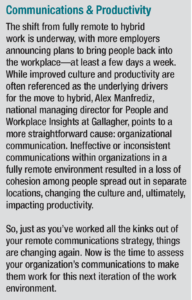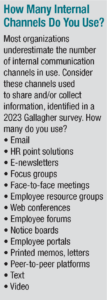Organizations increasingly rely on multiple and varied channels to support employee communications as the workplace becomes more digital. The move to remote work during the pandemic solidified (and added to) these channels—many adopted with little thought to their effectiveness or impact on outcomes. In an era of rapidly advancing technology and the shift from remote to hybrid work, it is time to rethink the purpose of internal communication, supporting technology, and its role and effectiveness relative to organizational well-being within an ever-changing employee landscape. A well-developed and implemented communications strategy will support a positive employee experience and drive talent retention. This article explores critical insights about creating an effective workforce connection and offers a guide to developing and implementing a communications strategy supported by effective technology tools.
More may not be better.
Managing the onslaught of business communications pushed out through multiple channels, including email, text, chat, LinkedIn, Slack, Teams, voice mail, and other technology channels, can be overwhelming. Add to this the communication capabilities included with most of today’s HR technology platforms, delivering enrollment reminders, payroll notifications, and similar transmissions. While technology adds significant value—increasing engagement and reducing one-way communications—adding channels ad-hoc with no thought to culture, optimized usage, or organization-wide management will detract from your communication effectiveness. Further, too many channels can create confusion about where to go for information, causing employees to take the path of least resistance—disconnecting altogether.
Communication shapes the employee experience.
The employee experience is directly impacted by what is communicated (too much, too little, unclear information, etc.). Employees do not value what they do not understand. Organizations that score high on employee experience typically have well-developed communications teams that consistently get out in front of issues.
Purposeful communication is integral to the culture, reducing uncertainty and eliminating the side chatter that results in misinformation, given the human tendency to make assumptions to fill the information vacuum. Communication also supports a sense of connectedness, which nearly half (49%) of employers said was a strategic priority in a July 2023 Gallagher organizational well-being poll.1
It is easy to overlook communications’ role in the employee experience. Suppose, in exit interviews, employees cite non-competitive benefits as the reason for leaving. Yet, a benefits consultant advises that the package is highly competitive. This scenario suggests that communications designed to promote the value of the benefits package are missing the mark.
With so much change in the workplace and more on the horizon, employers need to stop thinking about communications technology as a tool to push out information and instead consider how to integrate it into the organization’s culture to drive usage, effectiveness, and satisfaction. A 2022 Gallagher survey found that over a third (39%) of employers planned to make system and technology changes for 2023.2 Internal communications should be prioritized in places where organizations invest. A clear and focused communication strategy, utilizing an intentional set of channels supported by modern technology, is critical to creating a workforce connection that drives the employee experience. Following is a five-step guide to developing and implementing an effective internal communications strategy.

- Define the purpose of communication in your organization
What is your principal goal for communicating with your employees? You cannot strengthen your connection to your employees unless you first define the overarching purpose of internal communications—especially during times of significant change, such as we’ve experienced the past three years.
According to Gallagher’s State of Sector 2022/2023 report on internal communications and the employee experience, strategic alignment has traditionally been the most crucial purpose of internal communications. This finding remains the case for organizations with 5,000+ employees. However, organizations with fewer than 5,000 employees see culture and belonging as the primary purpose of internal communication, with strategic alignment being a sometimes distant second choice, especially for groups with less than 500 employees. Organizational agility ranked third across all organizations regardless of size.3 While there is value in knowing how your organization compares, it is more critical that organizational leaders are aligned and understand the purpose of internal communications to ensure buy-in for a communications strategy.
- Inventory internal communications channels
With a clearly stated objective for internal communications, examine your communications ecosystem. Begin with an inventory of channels (including HR tech point solutions), documenting how you use each and who oversees the track. You will likely discover channels spread across the organization. While HR is the most critical stakeholder for employee communications, just 22% of employers reported that responsibility for internal communications sits in HR, compared to 28% for the top-ranked corporate communications/public relations group.4
To bring focus to the mix of channels, organize them into three groups based on what they empower the organization to do:
- Share corporate messages.
- Drive collaboration and networking.
- Enable employees to find the information they need (self-serve).
Your inventory may uncover a duplication of channels, channels that no longer serve their intended purpose, and those with outdated technology. Use this as an opportunity to do some housekeeping, but the goal is not to limit or force the use of specific channels.
- Measure channel effectiveness.
Determine which channels are most effective and why. Measuring channel effectiveness is challenging but worth pursuing. Most companies start by measuring reach. In a hybrid work environment, reach is a critical component of effectiveness. Yet, less than three in four employers rated their channels’ ability to reach their audience as “good” or “quite good.” 5 The more employees, the more likely they struggle to  reach employees. Nearly half (46%) believe their organization does not invest enough in communication technology. While this data points to technology being the source of the problems, there are other factors to consider, including the content quality and lack of objective insights (versus subjective and personal perceptions) due to limited audience segmentation and personalization.
reach employees. Nearly half (46%) believe their organization does not invest enough in communication technology. While this data points to technology being the source of the problems, there are other factors to consider, including the content quality and lack of objective insights (versus subjective and personal perceptions) due to limited audience segmentation and personalization.
Tools to help measure effectiveness.
While reach is vital in a hybrid work environment, it alone does not make for effective communication. Other measurements include employee understanding, behavior change, business outcomes, and employee satisfaction with internal communications. While measurements for these areas are more subjective than those measuring reach, surveys provide quantifiable metrics to assess employee understanding and satisfaction, and interviews and focus groups offer additional insights. Look at adoption rates and employee turnover to gauge behavior change and business outcomes.
Employee feedback is essential to measuring effectiveness. In the Gallaher survey, 84% of employers agreed or strongly agreed that they valued employee feedback. However, less than half (47%) felt they had a robust process for capturing employee insights and feedback. Further, less than three in five respondents reported a consistent channel experience for all employees. Gallagher identified 16 “listening” channels to collect employee views and feedback. Topping the list of the “most used” channels are engagement surveys (69%), followed by email (55%) and input from people managers (51%).6
Beyond tools to invite and collect feedback, new AI technology, such as Aniline, enables employers to procure business intelligence by analyzing large amounts of data tied to employee perceptions—segmented by location, industry, population, and more. On a smaller scale, sentiment analysis tools analyze employee email, text, and social media posts for tone and emotion, providing insight into what your employees think.
Attributes associated with effectiveness.
So, what contributes to the subjective aspects of effectiveness? According to Drew Munn, digital strategy lead for Gallagher’s Communication Consulting Practice, COVID taught us the importance of employee control. “The more the user is in control of a channel, the more valuable it is to that user,” says Munn.
Other factors that boost employee use and satisfaction with a channel include personalization, ability to engage (two-way communication), and ease of use. A Businessolver study on user design for benefits communication found that 72% of employees expect personalization.7 AI enables greater personalization based on past actions and behaviors. For example, the communications function in a benefits point solution can combine benefit offerings, current selections, and claims data to push out personalized suggestions and reminders for using employee benefits.
The Businessolver study also found that 64% of employees expect some response (two-way communication) to their communications 24/7, e.g., chat. Younger employees have only known a time when you can do business digitally. The days of a 100% digital native workforce are just around the corner, and AI is fast-improving machine-generated conversation.
Ease of use may seem obvious for increased effectiveness, but the benefit extends further. A 2016 academic study 8 found that improved ease of use results in greater trust and satisfaction, which leads to adoption. Broad adoption of a preferred channel supports overall workforce connectivity.
Assess your channels for these characteristics. Think like a marketer—embrace and optimize those attributes that employees value most.
- Choose and optimize channel effectiveness.
Expect to support multiple channels. It is not feasible to rely on a single channel—whether for pushing out information or supporting two-way communications—and assume employees will meet you there. Different people use channels differently. Younger generations tend to embrace text and chat, while older generations are more likely to rely on email. Subsequently, senior management may be out of sync with their workers. The 2023 State of Workplace Communications report from Axios HQ found that 66% of leaders think they are aligned with employees, while only 44% of employees agree.9
While it is easy to assume management determines channel use, a culture of communications will develop on its own—especially in the absence of a well-developed communications strategy. Munn advises employers to pay attention if they wish to influence the communications culture. “Once set, it will frustrate employees if you try to force a change, risking employee engagement, satisfaction, and retention,” said Munn.
Some channels may be used exclusively by a single functional area. “Teams use different tools based on their needs and require different ways to communicate,” says Jon Shanahan, CEO of Businessolver, a fully remote organization. “Email is our default for corporate communications because it ensures everyone receives it, but we support multiple sub-channels—and sub-channels of sub-channels—because functional teams have embraced them as where the work gets done.”
- Create a channel strategy.
Shanahan recommends devising a strategy for each primary channel that feeds up to an overarching internal communications strategy—mapped out and followed by all functional areas. Key to this strategy is organizing your communications around themes, e.g., business updates, workplace culture, practical area workflows, timely announcements, and consistent use of various channels for themed messaging. For example, emails to share news from the C-suite, team messaging to support functional area communications and collaboration, a Monday morning text to announce what is happening this week, reminders, promotions, and other timely information.
According to Shanahan, functional areas within an organization may opt for different channels for similar needs. For example, Businessolver’s sales team uses Salesforce Chat, interfaced with the legal team, to manage the unique progression of sales contracts. The company uses ZIP for other contracts to manage communication associated with approvals, signoffs, etc., from start to finish. Your strategy should support varying channels built around functional areas and workflow.
Segmentation
Connectivity requires understanding your audience. With an increased focus on workplace culture and belonging, approaching your communication strategy by perceiving employees as unique individuals is critical. Through targeting and segmentation, communication technology can deliver the same experience to employees that marketing platforms provide consumers. However, the Gallagher survey found that only 11% of internal communicators maintain employee profiles or personas to understand and engage employee groups.10 Not surprisingly, larger organizations are more likely to do so.
Consistency matters
Above all else, strive for consistency. Create a channel map or calendar and stick to it. Establish internal rules for when and how to use channels and be prepared to call out people who don’t adhere to the rules. However, don’t allow the rules to inhibit innovation or creativity. Shifting, especially as your employees may already be there, is OK if a more effective channel bubbles up from within. However, be cautious about adding too many new channels without eliminating others, or you will find yourself back with a myriad of communication tools with little understanding of who is using what and why.
Connectivity and organizational well-being
Workplace communication technologies have revolutionized how employees connect and collaborate, enabling productive remote and hybrid work environments. Yet, employee channel satisfaction remains relatively low, especially among mid-sized organizations.11 As organizations seek to form stronger connections with their employees and deepen the employee value proposition, a carefully planned communication strategy is needed to maintain consistency and focus. Regular strategy evaluation and adjustments ensure a robust communications capability that supports the employee experience, leading to a more connected workforce and higher retention rates.
ENDNOTES
1 Organizational Well-being Poll, July 2023, Gallagher, https://bit.ly/49kQK1f
2 Gallagher. State of the Sector 2022/23: Internal Communication and Employee Experience. 2023 Workforce Trends Report Series. Published 2023, https://bit.ly/3FOsveg
3 ibid.
4 ibid.
5 ibid.
6 ibid.
7 Businessolver.com, Inc. Today’s employees demand personalization | Infographic | Businessolver, https://bit.ly/461e1Cr
8 Dellenbach D. Ease of Use is the Most Important Feature – Smore Blog – Medium. Medium. Published December 13, 2021, https://bit.ly/40sWEJV
9 The 2023 State of Essential Workplace Communications | Axios HQ. https://bit.ly/3Qp86la
10 Gallagher. State of the Sector 2022/23: Internal Communication and Employee Experience. 2023 Workforce Trends Report Series. Published 2023, https://bit.ly/3FOsveg
11 ibid.
